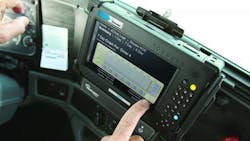Preparing for the digital transformation of business
A lot of folks in trucking might well respond “tell us something we don’t know” to the headline above, for the industry is already grappling with a wide array of digital transformers: everything from electronic logging devices (ELDs) and remote diagnostics to virtual navigation.
And that’s an incredibly short list, for it doesn’t even begin scratching the surface when smart phone applications are added to the mix.
Then of course there’s the whole ongoing “Internet of Things” or “IoT” push; a digital endeavor Steve Sashihara, the founder and CEO of Princeton Consultants, recently defined “in plain English” as basically real-time sensors connecting just about everything – cars, home appliances, etc. – to the Internet and furthering the creation of more precise “Big Data.”
Sashihara thinks 40% of the world right now is connected to the Internet, and though that means 60% that still needs to get connected, that 40% is a huge market.
Indeed, Ruggero Contu – research director at technology consulting firm Gartner – forecasts that 6.4 billion connected things will be in use worldwide in 2016, up 30% from 2015, and will reach 11.4 billion by 2018, though he cautions that considerable variation exists among different industry sectors as a result of different levels of prioritization and security awareness.
Princeton’s Sashihara emphasized that this rapid digitalization is going to help business broaden its strategic capabilities as well.
“We’re not just talking about internal data from our own machines, but the world of external data out there that is being used by forward looking people – particularly in the financial services industry, the finance industry, and the investment community – to try to understand market trend and competitive moves then use that to inform how we are making our decisions,” he explained.Sashihara cites this quote to put in context the importance of this “digital transformation” in business now occurring: “Information is the oil of the 21st century, and analytics is the combustion engine.”
Indeed, in Gartner’s recent 2016 CEO Survey: The Year of Digital Tenacity, a poll of 400 senior business leaders at companies with over $1 billion in annual revenue, found that a majority of CEOs now understand that digital business is substantial enough to warrant them leading it personally. If they delegate primary responsibility, then the next most likely leader is the CIO, the firm found.
“The rise in the number of CEOs heading up digital change is unsurprising given that half of the CEOs surveyed expect to see substantial digital transformation in their industries, or for their industries to be almost unrecognizable within five years,” noted Mark Raskino, Gartner’s vice president, noted in the company’s survey.
So what are some of the biggest “digital transformations” expected by this group of CEOs? The answers may surprise you:
- Self-driving vehicles.
- The rise of blockchain in the banking industry.
- The e-cigarette revolution in the tobacco market.
- The potential impact of Internet of Things (IoT)-fueled big data in the insurance market.
Raskino added that Gartner’s survey results also showed that CEOs appear to see “digitalization” as a positive force, not a destructive one.
Overall, chief executives are "very bullish" about the effects of digital change on the gross pre-tax profitability of their businesses, according to the firm's poll, with 84% saying that they expect digital change to bring higher profit margins.
“One explanation for CEOs' optimistic attitude toward digital change may be because they can see how it helps with the product innovations that matter to customers,” Raskino said.
“We asked CEOs what proportion of the customer perceived value of products and services they think is digital,” he added. “Thinking about the product features that customers are choosing and believe they are buying, CEOs believe the value percentage is already 30% on average and will rise to 46% by 2019.”
That could certainly apply to such things as the so-called “Uber for freight” movement within trucking.
One thing is for certain: the paper and pen seem to rapidly becoming obsolete in this newfangled world of ours. But let’s just hope we don’t lose touch with such basic skills – you never know when you might need them.

